THE CORSO PROMENADE
This type of promenade inscribes itself within an urban space historically characterised by its performative and staging qualities. This space is usually a stretch of road in a central position, about 1–1.5 km long, as straight as possible, and wide enough to accommodate performance and audience. In the ancient Roman cities, this stretch usually coincided with the cardus maximus or the decumanus maximus, and since then it has become the public thoroughfare along which centralised powers have staged triumphs and coronations, religious processions, festivals, races, and, from the 16th century, corsi delle carrozze and pedestrian promenades.
In their revival and reinvention of Roman tradition, medieval and Renaissance monarchs and popes introduced the corsa del palio horse race in several Italian cities to celebrate key feast days. At the same time, the social importance acquired by the corso made it an attractive residential environment for the nobility and gentry, whose palaces began to enrich its scenography while strengthening its role in urban representation.
THE CORSO PROMENADE
The favourite promenade street of Romans today, Via del Corso, offers an outstanding example of such a historical process. Known partly as Via Flaminia and partly as Via Lata in Ancient Rome, the street played, de facto, the key urban function of cardus maximus, the north-south axis, and its course has never since been changed.
It linked the northern gate of the city and the nearby Campus Martius with the Capitoline Hill and the heart of the city’s social life, the Forum, boasting major religious monuments like the Ara Pacis and, in great probability, portico complexes. Built as Via Flaminia around 220 BC, it had five triumphal arches, which provide evidence of the functions of displaying and parading bestowed on it by the political and military authorities from the very beginning.
In 1466 Pope Paul II relocated the carnival celebrations there. These included games and the horse races known as corse dei barberi, after which the street became known as Via del Corso.
Via del Corso, Roma, Engraving by H. W. Peckwell from a drawing by Ettore Tito, Scribner's Magazine, vol. X, 1891.
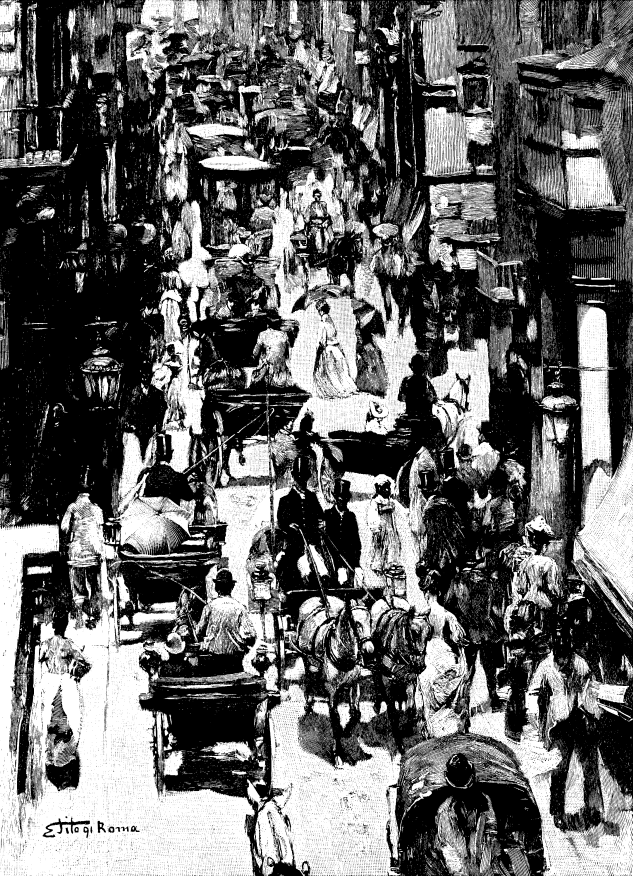
THE CORSO PROMENADE
The changes to the urban landscape that Rome experienced in the Renaissance strengthened the importance of the street, along which the 15th-century aristocracy and high clergy began to build their fashionable palazzi.
It is in this period that the street acquired its socialite character, while maintaining its functions as a route for religious processions and, above all, parades—for instance, for the entry of the Holy Roman Emperor Charles V in 1536 to meet Pope Paul III; and Queen Christina of Sweden on 20th December 1655 after her conversion to the Catholic Church. During his stay in Rome in 1580–81, the French writer and philosopher Michel de Montaigne noted that promenading was the most common activity among Romans and that there were streets specifically chosen for this purpose, probably in reference to Via del Corso.
By 1594, Rome already had 883 coaches, and, as these gained increasing popularity in the following decades, the promenade down Via del Corso by coach—the corso delle carrozze—became a tradition that lasted until the early 20th century.
THE CORSO PROMENADE
The corso delle carrozze and its concurrent pedestrian promenade thrived in the main Italian cities from the late 16th to early 17th century onwards by mostly relying on the same configuration of key elements, namely: a relatively long, straight, and wide central street; its upper-class residential character; in many cases, proximity to the cathedral; and display and parade functions historically taken on during political and religious events or key periodic festivals such as the carnival.
THE CORSO PROMENADE
In 17th-century Milan, according to Carlo Torre, the corso delle carrozze was first introduced during the carnival celebration on the Corso di Porta Romana, which the Spanish governor of the city, Duke Juan Fernández de Velasco, had straightened and enlarged around 1598. The street had played the key role of decumanus maximus in Roman times, when it linked the city’s forum to the main imperial gate opening onto the road to the capital.
The noble and magnificent palaces it had acquired during the Renaissance enhanced the parading character of the street, which was part of the route of the ‘magnificent’ and ‘solemn’ Corpus Domini procession established in 1336. From the 17th century, it functioned as the city’s ‘fashionable promenade’ —as the French writer Stendhal described it—until the Corso di Porta Orientale replaced it in the late 18th century.
THE CORSO PROMENADE
In 16th-century Florence, the corso delle carrozze took place along the route of the horse race traditionally run at least since the late 14th century on the feast day of the patron saint, John the Baptist (24th June). The route stretched from Porta al Prato to Porta alla Croce, along the former Roman decumanus maximus, i.e. the present-day Via degli Strozzi, Via degli Speziali, and Via del Corso. Initially associated with Carnival, the corso delle carrozze soon became a common winter parade between the palazzi of the wealthy families on Via del Corso and Borgo degli Albizi, though the route changed slightly throughout the centuries.
Piazza S. Croce during Carnival, Giovanni Signorini, 1846,
Florence, Palazzo Pitti, Galleria d'Arte Moderna.
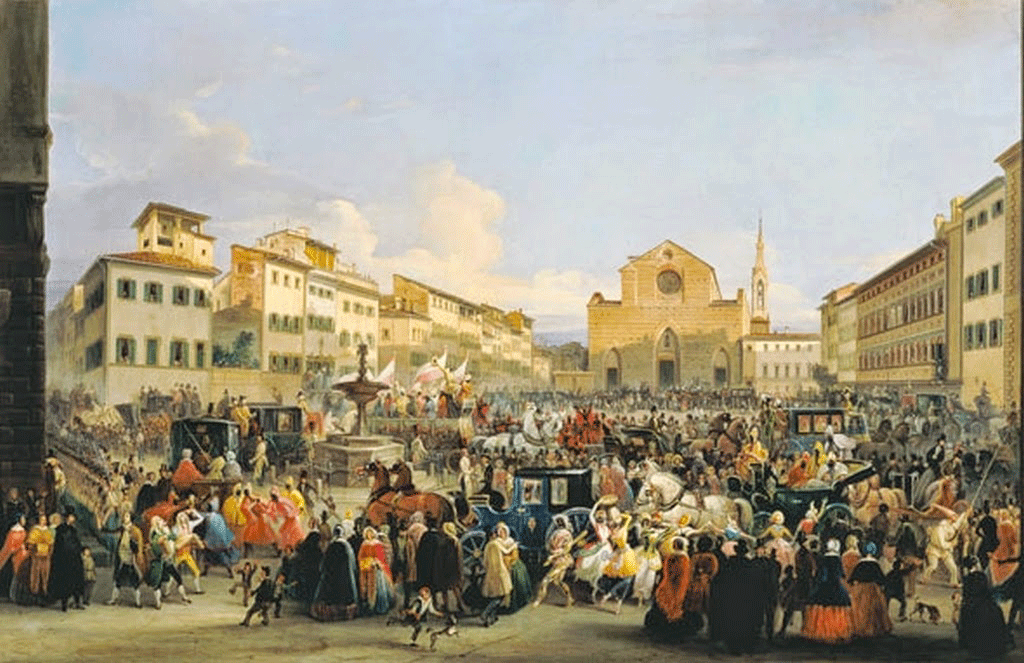
THE CORSO PROMENADE
Palermo’s winter promenade took place along Via Vittorio Emanuele, known as the Cassaro, which was the main urban axis of the Phoenician and later Arabic city, and functioned as the cardus maximus after the Roman conquest in 254 BC. In the 16th—18th centuries, the Cassaro’s magnificent palaces and the cathedral were the backdrop for corteges of nobles, religious processions, and Carnival celebrations that included horse races and the unique Palio di Santa Maria Maddalena, popularly known as the Corsa delle Bagasce: a foot race run by prostitutes (bagasce). The French diplomat and writer Dominique Vivant referred in 1778 to the bustle of carriages during the nobles’ promenade along the street in the early afternoon, and socialites maintained this habit throughout the 19th and early 20th centuries.
In present-day Palermo, the summer struscio has shifted to Via Maqueda, the straight street opened at the end of 16th century to cross the city from east to west along which the key historical palaces and the Teatro Massimo are found.
Via Maqueda, Palermo, 3 September 2017, © Museo del Camminare.
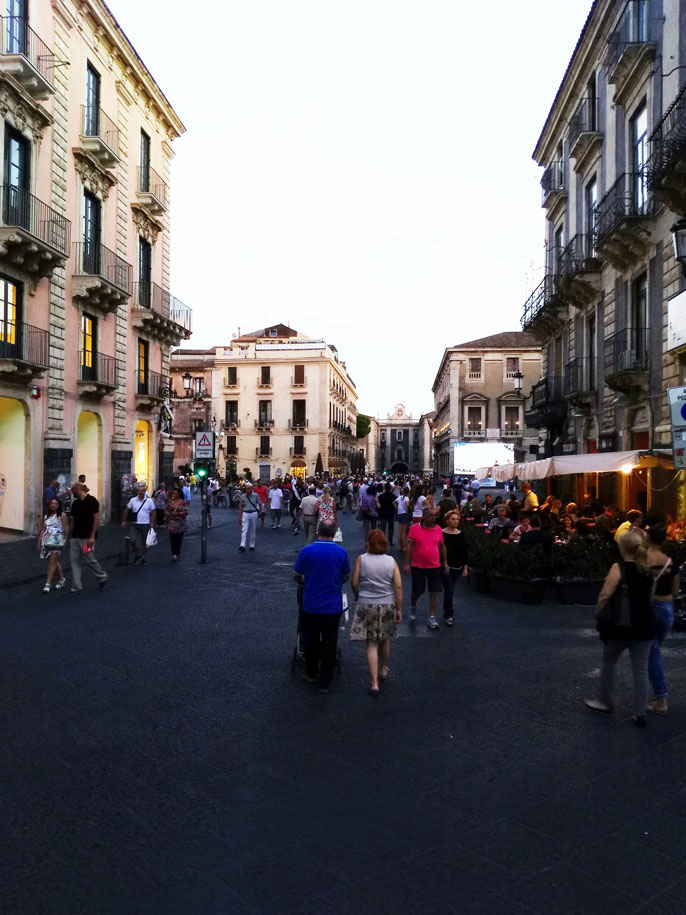
THE CORSO PROMENADE
Pavia in the 18th century had its corso delle carrozze in the Strada Nuova, which, in spite of the name acquired after its 14th-century reconstruction and straightening, was the ancient cardus maximus of the city. The street flanks the historical, religious and political centres of the city: the cathedral and the Broletto Communal Palace. In the early 19th century, the British traveller Lady Morgan was still able to point how ‘in the evening, the Strada Nuova is the Corso, not only for the few old carriages with the few old nobles who occupy them, but the lounge of all the young students of the university’ and ‘the pedestrians of all classes and ages’.
In other cases, the coach and pedestrian promenades developed from streets created in the 16th and 17th centuries. In Torino, for instance, the 17th-century Via Po was the broad and straight continuation of the city’s decumanus maximus outside the southeastern gate. In the 17th century, it became the route for the corso delle carrozze during Carnival, as well as for the usual winter promenade between ‘high edifices with porches of homogeneous design’, as Boccolari wrote in 1782.
THE CORSO PROMENADE
In many Italian cities, the promenade still takes place on a street the display and parading functions of which are centuries and even millennia old.
The Senese promenade, for instance, is in Via Banchi di Sopra, known in the past as the Corso, through which both the city’s horse race and the corso delle carrozze took place. The medieval Palio alla Lunga was run along the north-south urban stretch of the Via Francigena—perhaps the ancient Roman cardus maximus of the city—from the northern Porta Camollia to the Duomo, or to the latter from the southern Porta Romana, while the corso delle carrozze was held outside Porta Camollia and between the palazzi of the eminent families on the Corso.
Parma has its promenade in Via Cavour, which was part of the Roman cardus maximus of the city and runs through the main public square—the former forum—flanking the centre of the political power, the 12th-century communal palace. It was the route of the Palio dello Scarlatto, recorded since 1314, and the celebratory thoroughfare leading to the cathedral.
THE CORSO PROMENADE
Perugia still stages its urban promenade in Corso Vannucci, of which the architect and cultural historian Bernard Rudofsky included a photograph in his seminal 1964 Streets for People, emphasising how every afternoon the corso was hosed down and closed to cars in preparation for the promenade. This wide and straight street was the cardus maximus in Roman times and the heart of the medieval city. The cathedral and several patrician palaces flank the corso, which crosses the main public square, Piazza IV Novembre—the ancient forum, in which stands the 14th-century centre of political power, Palazzo Priuli. An Etruscan triumphal arch, later known as the Arco d’Augusto, still marks the northern gate that once opened onto the corso, through which passed festival corteges, religious processions, triumphal entries—like that of Pope Pio IX in 1857—and promenaders in coaches and on foot.
Corso Vannucci, Perugia, Bernard Rudofsky, Streets for People, 1969.
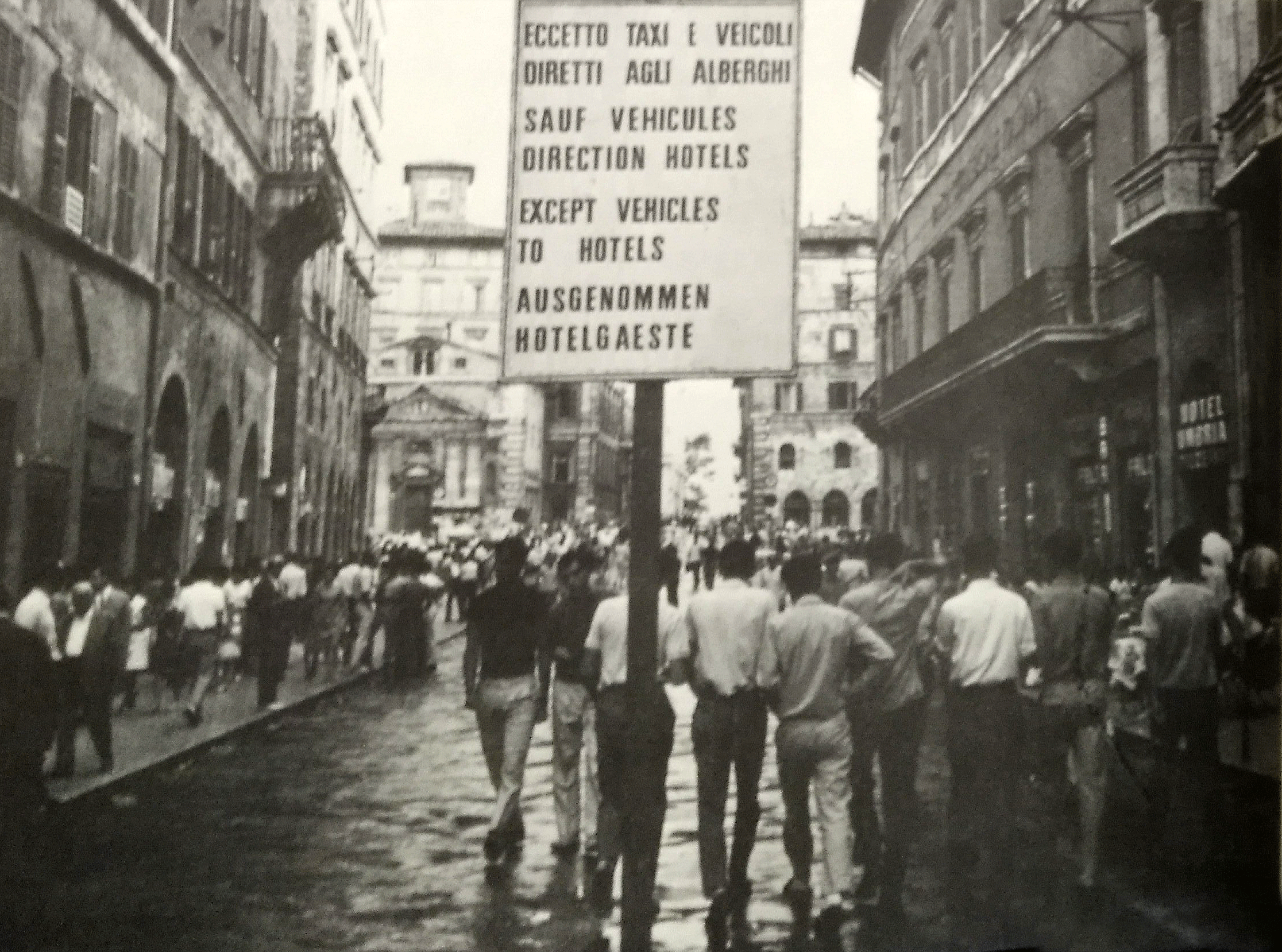
THE CORSO PROMENADE
Via Toledo in Naples offers an excellent example of the overlap that historically occurred between social and religious practices. It had such a ‘multitude of Coaches that passe to and fro’, wrote Raymond in 1648, that in 1704 the Spanish viceroy prohibited the circulation of carriages on Holy Thursday and Good Friday, when it was the tradition to visit seven churches along the street for the Adoration of the Holy Sepulchre. Either the rustling of the silk gowns worn by the noble women or the sound made by the people as they dragged their feet along the paving stones seem to be the origin of the term struscio, a name first given to the event in the 18th century and still used in reference to the city promenade in Naples and many other Italian cities.
The Marquis de Sade was on Via Toledo during the Holy Week of 1776 and was struck by the sight of the beautiful litters in which the noble women were carried, the valets, the porters, the pages and the richly clothed gentlemen. In the 18th and 19th century, Via Toledo thus provided a key opportunity for the socialites to display their spring fashions in the struscio and to parade during Carnival, thereafter assuming its place as the site of the Saturday and Sunday promenades.
Via Toledo from the Largo dello Spirito Santo, Gaetano Gigante, 1837,
Naples, Museum of S. Martino.
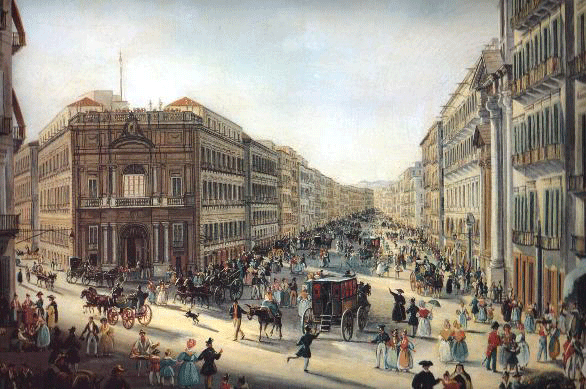
THE CORSO PROMENADE
In Venice, where the historical urban fabric is peculiarly intricate and compact, the absence of a straight and wide street for promenading was obviated in the 16th and 17th centuries by laying straight strips of Istrian stone across what had previously been dirt squares, such as Campo Santo Stefano, Campo San Polo, and Campo Santa Maria Formosa.
The word liston, the traditional Venetian term for a public promenade, probably came from those strips or from the lines of white marble laid in the flags of St Mark’s Square in 1406 to demarcate the Saturday market stalls and that came to function as a reference point for corso-like paths.
The promenade was performed up and down the piazza along the east-west axis. Opening up in front of the centres of both political and religious power—the Doge’s Palace and, beside it, the basilica—the public space of St Mark’s Square became the main site for urban displays and parades from medieval times onwards. Ascension Day and Carnival Thursday began to be celebrated here in the 12th century and, before the current 18th-century pavement was laid, the square hosted horse races, jousts and tournaments.
El liston, Giacomo Favretto, 1884, Rome, GNAM.
Modern Liston, Giacomo Favretto, 1887, private collection.
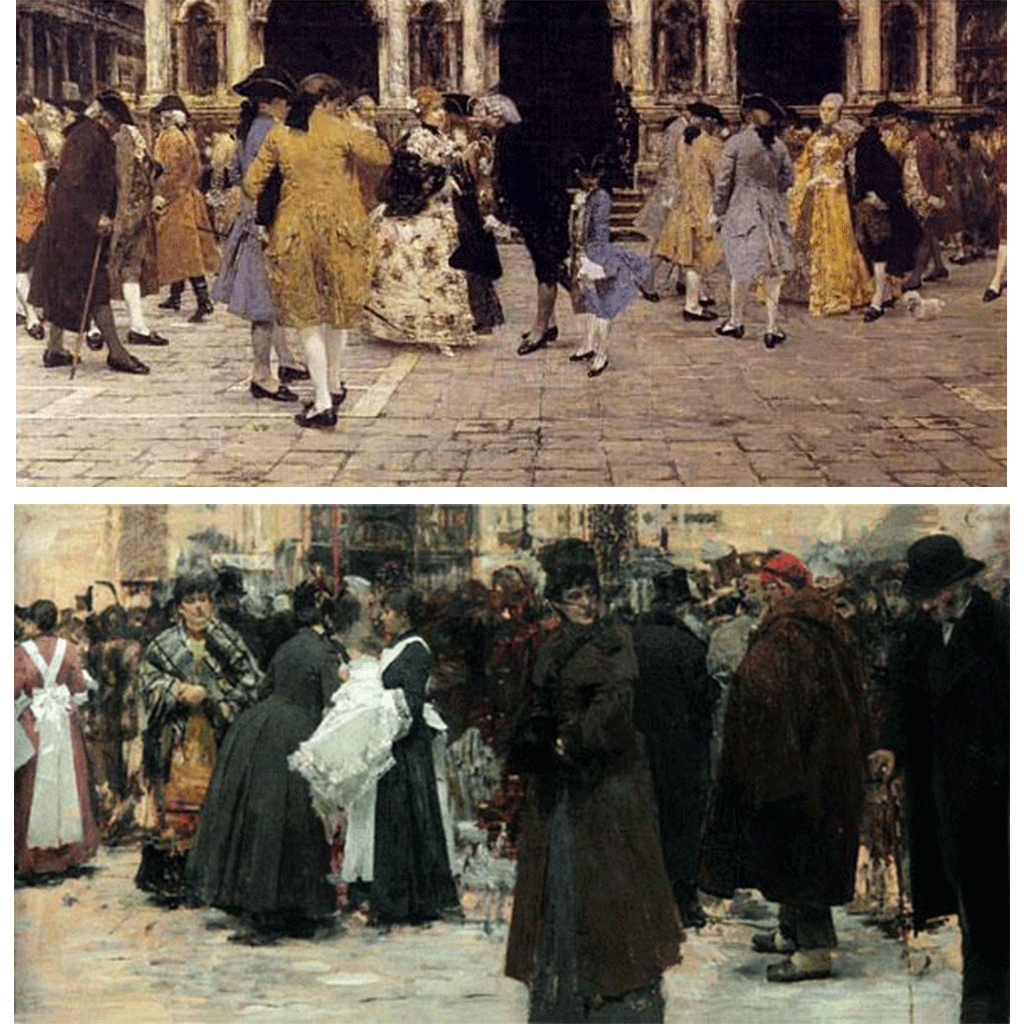
THE CORSO PROMENADE
The liston in St Mark’s Square was performed until the 1970s, when the massive out-migration of citizens and inflow of tourists began to dramatically alter the social fabric of the city, putting an end to one of its more vital rites.
During the Republic of Venice, the Venetian liston became the model for many cities and towns that were under the rule of the Venetian Republic. In Padua, the liston crosses the elliptical garden at the centre of the triangular square known as Prato della Valle; since the late 18th century, Verona had its liston built on the western side of Piazza Bra; in Belluno, the liston crosses the historic heart of the city, Piazza dei Martiri, flanking the porches of the palaces on the northern side of the square; in Rovigo it crosses the present-day Piazza Vittorio Emanuele II; while the liston of Portogruaro stretches from Calle Beccherie to the cathedral.